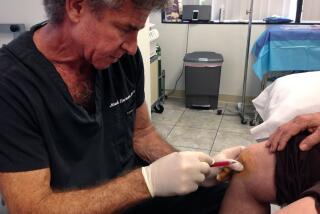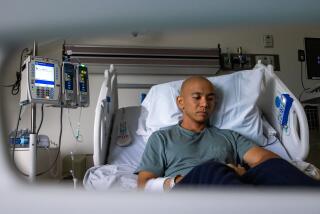Column: A gruesome case study points to the hazards of stem cell tourism
Medical regulators have been warning that the downside of unproven stem cell treatments isnât merely that they wonât work, but that they can be life-threatening.
A team of Canadian physicians has just reported an especially gruesome example of what can go wrong when desperate patients chase after last-ditch cures in whatâs known as stem cell tourism. Their subject is a 38-year-old Newfoundland man who became a paraplegic after a trampoline accident at the age of 20 injured his spinal column.
Six years later, he traveled to Portugal for a stem cell treatment. Doctors there transplanted olfactory mucosal cells drawn from his upper nasal passages into the site of his spinal injury. He never got better, but years later started getting worse.
We want to make sure the same thing doesnât happen to anyone else.
— Nanette Hache, physician
Doctors at Memorial University of Newfoundland discovered that the olfactory cells had never differentiated into neuronal cells, as the Portuguese clinic apparently expected, but kept growing on their own, producing a tumor of nasal cells thatâs now too large to be surgically removed.
âThis was a young man with a life-altering injury and would have tried anything for a chance to walk again,â Nanette Hache, one of the physicians, told me. The Portuguese operation cost $50,000, plus possibly that much more for travel, accommodations and postoperative support. The doctors published (with the patientâs consent) âbecause we want to make sure the same thing doesnât happen to anyone else.â
As many as three other similar cases have been identified in scientific journal reports, according to Leigh Turner, a bioethicist at the University of Minnesota who has been tracking the proliferation of unproven stem cell treatments for several years. All went to the same clinic in Portugal, which has claimed to have treated more than 120 patients.
Medical experts have started warning in earnest of the hazards of stem cell tourism. As regulators in the U.S., Canada and parts of Europe have cracked down on promoters of stem cell treatments that have no scientific validity, clinics in less-regulated locales have stepped into the void. These promoters are not only relatively unaccountable to government oversight, they often can avoid reporting negative outcomes of their handiwork that might warn off potential victims.
Last year, Berlin-based researchers compiled a list of 35 adverse incidents resulting from unproven stem cell treatments performed mostly in China, Thailand, Argentina, Mexico, Costa Rica, Egypt, Dominican Republic and Russia. Some were done in Germany, Australia and the U.S. as well. The negative outcomes included tumors, blindness, brain hemorrhages, strokes, pneumonia and death.
The researchers observed, however, that their list was almost certainly incomplete, in part because the true number of treatments is unknown. The evidence at hand, however, indicated âsubstantial patient exploitation using the âpower of hope.ââ
Credulous media reports add to the dangers. Consider the recently reported experience of Caroline Wyatt, a prominent BBC journalist who at the age of 49 underwent a stem cell treatment for multiple sclerosis in Mexico in 2017, lured there by reports (on the BBC) of ânear miraculous results.â She raised $84,000 from friends and family, because Britainâs health system wouldnât cover the procedure. A month after her treatment, she told a BBC news program that she was âfeeling better than I have done in a long time.â
The improvement didnât last. In a follow-up report in February, she acknowledged that âtoday, I often feel worse than I did before.â Of the patients she has kept in contact with, some reported improvements, but others little change. âA few have said that they now feel worse than they ever did before ... and wish they had never had the treatment.â As she acknowledges, the causes of MS â and therefore the proper treatments â are unknown.
Clinics offering stem cell-based nostrums in the U.S. typically use cells derived from fat, removed from patients by liposuction, purportedly treated to concentrate the stem cells, which are then injected into a customerâs body.
The use of olfactory cells appears to be a relatively novel application for spinal cord injuries. The process isnât utterly devoid of scientific logic. Olfactory mucosal cells have neuronal features and are known to regenerate themselves, which suggests they could fulfill the function of spinal cells, which donât regenerate, at least in theory.
âItâs not entirely âout there,ââ Hache says. âLegitimate research is being done, but as for the next leg, transplanting them in patients â weâre not there yet.â
One problem made evident from the Newfoundland case and others is that the tumors caused by the transplants may not develop for years. The Portuguese clinic, which reported on the experiences of 20 patients in 2010, followed up on the patients only for an average of about two years and none for more than four.
The Newfoundland patientâs tumor, however, didnât make its presence known for more than seven years after his transplant, and then only because his condition was worsening as the tumor grew.
The lesson, Turner says, is that âif you put the wrong kind of cells in the wrong place bad things can happen, even if symptoms donât manifest right away.â
Keep up to date with Michael Hiltzik. Follow @hiltzikm on Twitter, see his Facebook page, or email [email protected].
Return to Michael Hiltzikâs blog.
More to Read
Inside the business of entertainment
The Wide Shot brings you news, analysis and insights on everything from streaming wars to production â and what it all means for the future.
You may occasionally receive promotional content from the Los Angeles Times.











